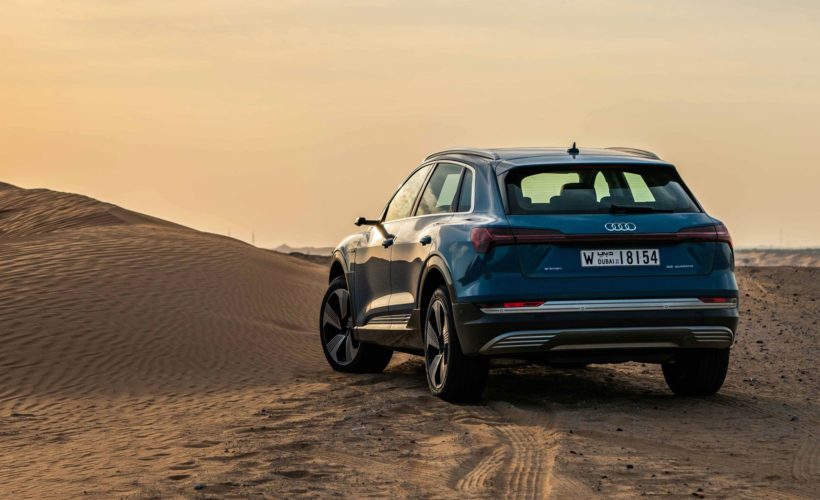First it was the Jaguar I-Pace. Researchers studying electric vehicle performance at Carnegie Mellon University were surprised last fall when the sporty electric crossover received a disappointing range rating from the EPA. The 234-mile rating, from a 90-kWh battery, was six miles short of what Jaguar had projected, and 16 miles short of the researchers’ own estimates. That difference might not seem like much—until you’re stranded on the side of the highway.
Now it’s an Audi crossover’s turn to disappoint. The company’s electric E-tron SUV, which goes on sale next month, just received its own EPA rating: 204 miles from its 95-kWh battery. That’s about 20 miles shy of what many had projected (though in line with a few too), a disparity that often occurs with electric vehicles because the EPA’s real-world testing can’t always be readily duplicated by researchers and manufacturers.
The E-tron’s numbers are particularly unfortunate for Audi when compared with the current electric vehicle king, Tesla, which the EPA rates up to 295 miles on its comparable Model X SUV. The car generates 74 miles per gallon equivalent, compared with the I-Pace’s 76 and the Model X’s 93.
The Audi E-tron generates 74-miles per gallon equivalent, according to the EPA’s new rating.
As for the “why”—well, it gets complicated. Electric vehicle range has lots to do with batteries, sure, but also technology choices, vehicle weight (Audi hasn’t released the E-tron’s yet), and even engineering strategies.
For one, it appears the premium Tesla competitors’ battery systems are less efficient, and less prepared for the long haul. The Audi and Jaguar EVs deliberately use only 88 percent and 94 percent of their battery capacities, respectively. Carnegie Mellon researcher and mechanical engineer Shashank Sripad says this is probably to preserve the lithium-ion batteries’ health as they naturally degrade over time. (The stress of frequent charging can spur that degradation.)
Tesla, by comparison, appears to have better battery-engineering prowess, and more experience with the technology. “One of the possible reasons for Tesla going with the full nominal capacity could be that they have a better thermal management system, which makes sure the battery doesn’t degrade as much even with full capacity,” Sripad says. Tesla CEO Elon Musk has also suggested the company has found a way to use more of its battery without compromising longevity—a sign that the electric car company is more confident in its batteries’ abilities to hold full charges without breaking down over time.
Audi spokesperson Mark Dahncke says the company balanced the E-tron’s range with longevity, repeatability, and luxury features.
Tesla might also be better at wringing more miles out of the battery because the company has a decade’s worth of research as a head start. (The Model S debuted in 2012, and the original Roadster back in 2008.) “It takes 10 years to do a 10-year cycle life test,” says Venkat Viswanathan, also a mechanical engineer with Carnegie Mellon. As a result, Tesla probably has better data on the batteries’ life spans and performance.
Audi spokesperson Mark Dahncke argues the E-tron is designed to be dependable, capable, and to perform no matter how much its charge is depleted—even if that means slight compromises on range. “We took a different approach than our competitors that balances range with longevity and repeatability,” Dahncke says. He also notes the car’s luxury amenities, including heating and cooling and a towing capacity of 4,000 pounds—all of which tax the battery.
And, sure, if you’re in the market for a premium electric vehicle, chances are you’re looking at features other than range. For one, price: Compare the E-Tron’s starting $74,800 against the Model X’s $89,500 and the Jaguar’s $69,500. Charging infrastructure is also important, and Volkswagen-owned Audi is pouring $2 billion by 2027 into its fast-charging Electricity America network, which is funded by its Dieselgate settlement with the EPA. Compare its high-speed charging stations, up to 150 kW, with Tesla’s 120 kW ones. That network is still very much a work in progress, but it could allow E-tron owners to top off 54 miles of range in just 10 minutes. (Teslas need special adapters to use the Electrify America–funded chargers.)
The best news for electric SUV fans is that more are coming. Next up is the Mercedes EQC. Mercedes-Benz hasn’t released its basic stats, but says the EQC’s New European Driving Cycle range estimate—a European methodology that usually generates figures about 20 percent higher than EPA’s calculations—is 279 miles. Will that hold up? “It’s hard to say,” Sripad says, “but the trend is not looking promising.”
More Great WIRED Stories
- The best laptops, from MacBooks to Chromebooks
- Mar-a-Lago’s security problems go beyond a thumb drive
- What Boston Dynamics’ “Handle” robot really means
- “Why don’t you want kids?” “Because apocalypse!”
- Ferrari built the track-slaying P80/C for a single customer
- ? Looking for the latest gadgets? Check out our latest buying guides and best deals all year round
- ? Want more? Sign up for our daily newsletter and never miss our latest and greatest stories
Source:WIRED











